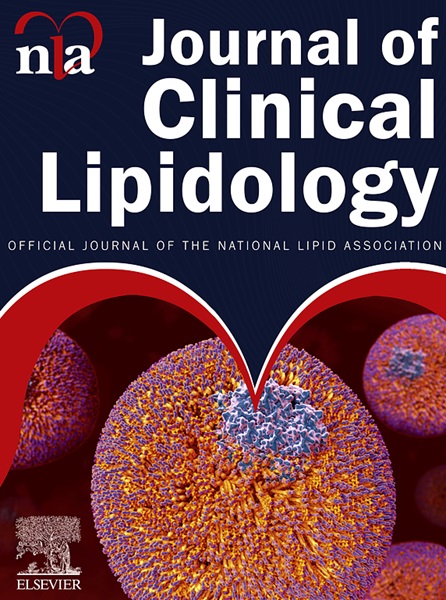Recognition and management of persistent chylomicronemia: A Joint Expert Clinical Consensus by the National Lipid Association and the American Society for Preventive Cardiology
IF 4.6
3区 医学
Q2 PHARMACOLOGY & PHARMACY
引用次数: 0
Abstract
Extreme hypertriglyceridemia, defined as triglyceride (TG) levels ≥1000 mg/dL, is almost always indicative of chylomicronemia. The current diagnostic approach categorizes individuals with chylomicronemia into familial chylomicronemia syndrome (FCS; prevalence 1-10 per million), caused by the biallelic combination of pathogenic variants that impair the lipolytic action of lipoprotein lipase (LPL), or multifactorial chylomicronemia syndrome (MCS, 1 in 500). A pragmatic framework should emphasize the severity of the phenotype and the risk of complications. Therefore, we endorse the term “persistent chylomicronemia (PC)” defined as TG ≥1000 mg/dL in more than half of the measurements to encompass patients with the highest risk for pancreatitis, regardless of their genetic predisposition. We suggest classification of PC into 4 subtypes: (1) genetic FCS, (2) clinical FCS, (3) PC with “alarm” features, and (4) PC without alarm features. Although patients with FCS most likely have PC, the vast majority with PC do not have genetic FCS. Proposed alarm features are: (a) history of recurrent TG-induced acute pancreatitis, (b) recurrent hospitalizations for severe abdominal pain without another identified cause, (c) childhood pancreatitis, (d) family history of TG-induced pancreatitis, and/or (e) postheparin LPL activity <20% of normal value. Alarm features constitute the strongest risk factors for future acute pancreatitis risk. Patients with PC and alarm features have very high risk of pancreatitis, comparable to that in patients with FCS. Effective, innovative treatments for PC, like apolipoprotein C-III inhibitors, have been developed. Combined with lifestyle modifications, these agents markedly lower TG levels and risk of pancreatitis in the very-high-risk groups, irrespective of the monogenic etiology. Pragmatic definitions, education, and focus on patients with PC, specifically those with alarm features, could help mitigate the risk of acute pancreatitis and other complications.
持续性乳糜微粒血症的识别和管理:国家脂质协会和美国预防心脏病学会的联合专家临床共识。
极端高甘油三酯血症,定义为甘油三酯(TG)水平≥1000mg /dL,几乎总是乳糜微粒血症的指示。目前的诊断方法将乳糜微粒血症患者分为家族性乳糜微粒血症综合征(FCS;患病率1-10 /百万人),由致病变异的双等位基因组合引起,这些变异损害了脂蛋白脂肪酶(LPL)的溶脂作用,或多因素乳糜微粒血症综合征(MCS, 1 / 500)。一个实用的框架应该强调表型的严重性和并发症的风险。因此,我们认可“持续性乳糜微血症(PC)”一词,定义为在超过一半的测量中TG≥1000 mg/dL,以涵盖胰腺炎风险最高的患者,无论其遗传易感性如何。我们建议将PC分为4个亚型:(1)遗传性FCS,(2)临床FCS,(3)有“报警”特征的PC,(4)无报警特征的PC。尽管FCS患者很可能患有PC,但绝大多数PC患者并没有遗传性FCS。提出的报警特征有:(a)反复发作的tg诱导的急性胰腺炎史,(b)反复发作的无其他明确原因的严重腹痛住院史,(c)儿童胰腺炎,(d) tg诱导的胰腺炎家族史,和/或(e)肝素后LPL活性
本文章由计算机程序翻译,如有差异,请以英文原文为准。
求助全文
约1分钟内获得全文
求助全文
来源期刊
CiteScore
7.00
自引率
6.80%
发文量
209
审稿时长
49 days
期刊介绍:
Because the scope of clinical lipidology is broad, the topics addressed by the Journal are equally diverse. Typical articles explore lipidology as it is practiced in the treatment setting, recent developments in pharmacological research, reports of treatment and trials, case studies, the impact of lifestyle modification, and similar academic material of interest to the practitioner.
Sections of Journal of clinical lipidology will address pioneering studies and the clinicians who conduct them, case studies, ethical standards and conduct, professional guidance such as ATP and NCEP, editorial commentary, letters from readers, National Lipid Association (NLA) news and upcoming event information, as well as abstracts from the NLA annual scientific sessions and the scientific forums held by its chapters, when appropriate.

 求助内容:
求助内容: 应助结果提醒方式:
应助结果提醒方式:


